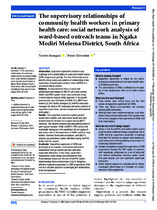| dc.contributor.author | Assegaai, Tumelo | |
| dc.contributor.author | Schneider, Helen | |
| dc.date.accessioned | 2020-02-20T12:50:18Z | |
| dc.date.available | 2020-02-20T12:50:18Z | |
| dc.date.issued | 2019 | |
| dc.identifier.citation | Assegaai, T., & Schneider, H. (2019). The supervisory relationships of community health workers in primary health care: Social network analysis of ward-based outreach teams in Ngaka Modiri Molema district, South Africa. BMJ Global Health, 4(6) doi:10.1136/bmjgh-2019-001839 | en_US |
| dc.identifier.issn | DOI: 10.1136/bmjgh-2019-001839 | |
| dc.identifier.uri | http://hdl.handle.net/10566/5197 | |
| dc.description.abstract | Introduction Supportive supervision remains a key challenge to the sustainability of community health worker (CHW) programmes globally. The aim of the study was to identify critical actors and patterns of relationships in the supervision of ward-based outreach teams (WBOT) in a rural South African district.
Methods A cross-sectional study of social and professional relationships of WBOTs with other primary health care (PHC) system actors was conducted using
a social network analysis (SNA) approach. A structured questionnaire was distributed to CHWs (37), WBOT team leaders (3), PHC facility managers (5) and PHC local area managers (2) (total n=47) assessing interaction patterns of supportive supervision, namely management, development and support.
results The supportive supervision system pivoted around team leaders, who were nurse cadres and who ensured internal cohesion and support among WBOT members. The network patterns also showed the extent of peer support between CHWs in WBOTs. PHC facility staff and middle managers in the subdistrict did not appear to play active roles in the supervision of CHWs and their team leaders. However, there were exceptions, with WBOTs drawing on sympathetic cadres identified among the PHC facility staff for support.
Conclusion Supportive supervision of CHWs can
be thought of as a system of horizontal and vertical relationships that go beyond just one supervisor– supervisee interaction. In this study, supervisory relationships within teams functioned better than
those between teams and the rest of the PHC system. Understanding these relationships is key to designing effective supportive supervision in CHW programmes. SNA can be a valuable approach in identifying the relationships to be strengthened. | en_US |
| dc.language.iso | en | en_US |
| dc.publisher | BMJ Global Health | en_US |
| dc.subject | Community health workers | en_US |
| dc.subject | Social network analysis | en_US |
| dc.subject | Supervision | en_US |
| dc.subject | Support | en_US |
| dc.subject | Ward-based outreach team | en_US |
| dc.title | The supervisory relationships of community health workers in primary health care: Social network analysis of ward-based outreach teams in Ngaka Modiri Molema District, South Africa | en_US |
| dc.type | Article | en_US |

